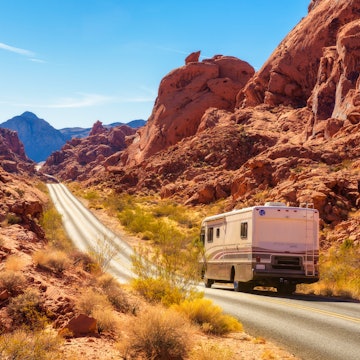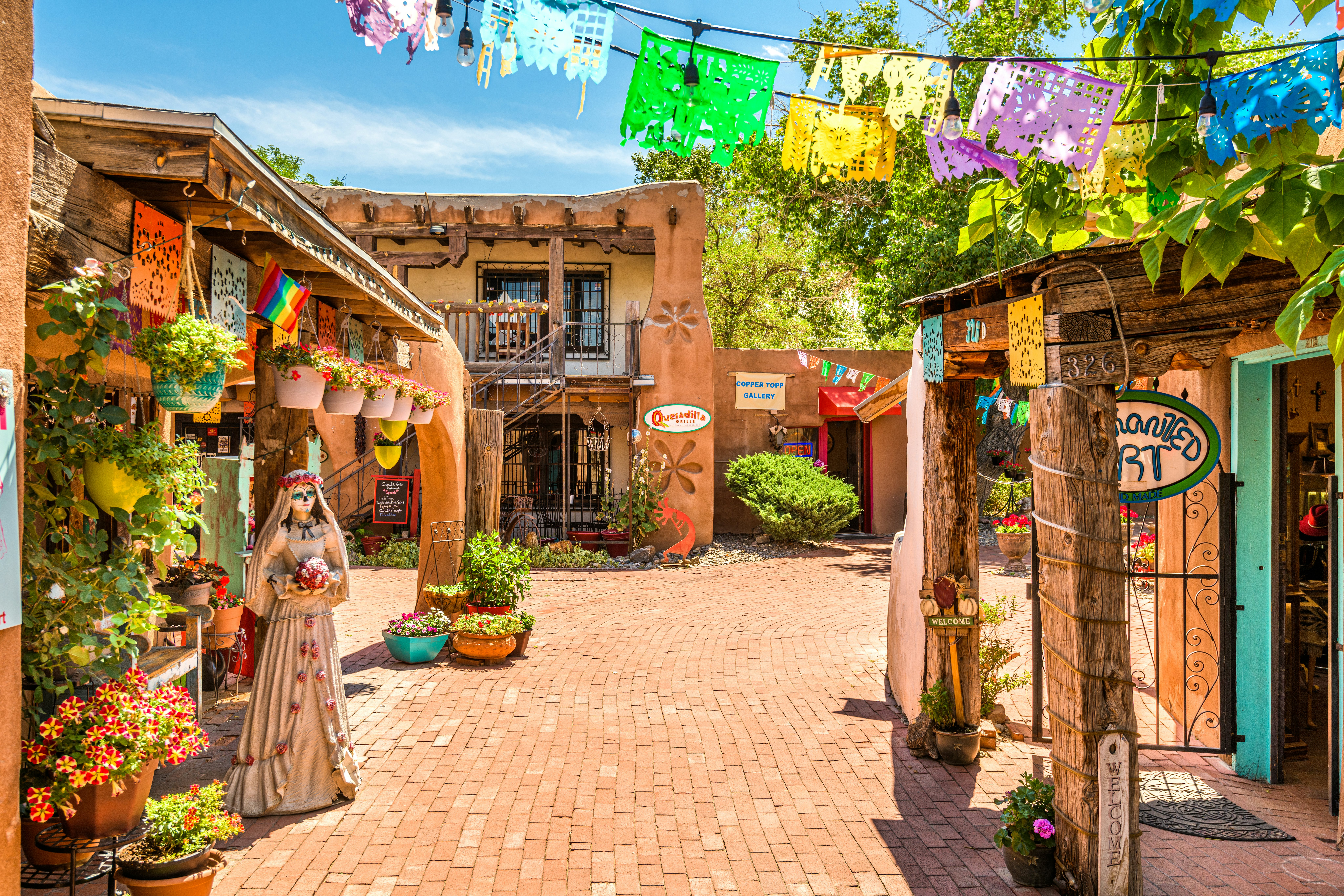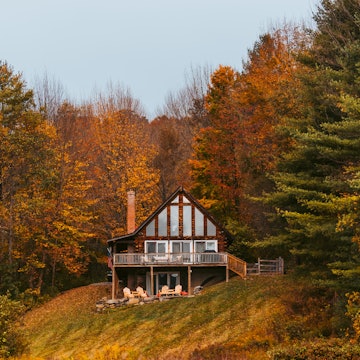

Sandia Mountains at sunset, Albuquerque, New Mexico. Mark Sweeney/500px
From outdoor adventures to relaxed dinners under incredible sunsets, Albuquerque is a laid-back city steeped in centuries of diverse cultures. It's a place that celebrates creativity in its cuisine, art, music and architecture. And at 5300ft, you'll experience weather from hot summer days to snow blanketing the Sandias.
From the corners of Old Town to the wilderness playground that is the Sandia Mountains, here are the top things to do.
1. Experience the world's largest balloon festival
Every year for nine days in early October, nearly 1 million people flock to the International Balloon Fiesta on the northern edge of Albuquerque city limits. People arrive at the grounds before sunrise and are ushered into parking lots (shuttles can get you to the grounds and an app tracks where you parked). Dozens of vendors offer everything from loaded ribbon fries to hot coffee and, of course, breakfast burritos. At dawn, referees in striped uniforms clear the hordes as balloons are laid out flat before being launched one by one. Besides sunrise flights, events include drone shows, chainsaw exhibitions, a sunset flight and fireworks.
Planning tip: Riding in a balloon is typically reserved for local crews, though Rainbow Ryders offers a handful of visitor spots. You’ll have a better chance of booking sunrise flights throughout the year.
2. Learn about the city's history and art at the Albuquerque Museum
The Albuquerque Museum has the unenviable task of trying to make sense of this complicated city’s history, but it takes a good stab at it with a diverse range of paintings and portraits, war memorabilia, photography and the story behind New Mexican inventions like Altair, the first commercially successful personal computer.
Two permanent exhibitions include Only in Albuquerque and Art of New Mexico, the latter about the urban and natural landscapes that have been inspiring art in the state for some 13,000 years. Only in Albuquerque, meanwhile, is an interactive collection of four galleries under the themes Spirited, Innovate, Courageous and Resourceful, telling the story of the first settlers in the area to the present day.
Rotating special exhibitions take place in the other galleries, from nuclear communities to the night sky to iconic modernists Georgia O’Keeffe and John Moore.
Planning tip: If you plan on visiting the adjacent Old Town too, buy your museum entry ticket first (you get three hours’ parking for free for your $6 entry ticket – which is cheaper than if you were buying parking alone). Bags have to be locked in lockers (free) during a visit.

3. Wander the historic Old Town
Once a homeland for the Tiwa people starting around 1250, Alburquerque (yes, it originally had an extra ‘r’ after the Spanish town) was overtaken by Spain in the 1680 Pueblo Revolt, and in 1706, 15 Spanish families settled here in the Old Town. The neighborhood’s plaza and San Felipe de Neri Church (look out for the Virgin de Guadalupe carved inside a tree trunk outside the church) were the hub of daily life and a major rest stop for those passing through. Outlaw Billy the Kid allegedly frequented a brothel or two here in the 1870s. In 1880, the railroad arrived downtown and Old Town was no longer Albuquerque’s hub.
The plaza graciously remained, though as a touristy area lined with tchotchke souvenir shops, street vendors and weekly drive-bys from bikers and vintage-car owners revving their engines. Those all remain, but Old Town is starting to evolve, with shops and galleries promoting New Mexican artisans hoping to revamp the historic core.
Planning tip: When your feet get tired, have a Southwestern lunch at Church Street Cafe, before tasting chile wine at Noisy Water Winery and pondering the cool art in the adjacent Lapis Room.
4. See 'haunted' Old Town at night
Old Town is even better at night when the ghosts come out. There have been sightings of a redheaded woman on the balcony above the Covered Wagon gift shop, and a woman in a wedding dress on the stairs of an empty storefront on the east side of the plaza. And couples, beware of the hatchet-wielding lady – she’s a jealous one. To learn all about Old Town’s haunted history, book a tour with AbqTours located in a square atop a church burial ground (of course). The nightly lantern-lit walking tours will take you to the top haunted sites and down back alleys. Guides are animated, and the recordings of ghost sounds are bound to give you the willies. Public ghost tours are also a great way to learn about Old Town’s history in general.

5. Hike in the Sandia Mountains
There are more than 100 hiking trails over the Sandia Mountains, ranging from 1-2 hours long to full-day hikes. One of the most pleasant ways to appreciate the views and scenery is to hike the trails on the top of the mountain. The Kiwanis Cabin via Crest Trail is a terrific 2-mile hike through pine forests, with a nature trail and intermittent views over the city and Rio Grande Valley, to a pueblo-style structure. Another great option is to hike the La Luz Trail and catch the tram back down – it’s 9.7 miles from the base of the mountain, or 6.2 miles from the entrance to the tram. Be aware that this is some serious altitude change (more than 10,000ft) - carry lots of water and don’t hike in the peak of summer. If your legs are tired but you still want to appreciate the views, ride the Sandia Park Tramway to the top.
Planning tip: Download trail-map info before you set off, and grab a trail map when you buy your ticket; trail info is scarce on the noticeboards on the mountain summit.
6. Enjoy elevated dining
On Sandia Peak, the Ten 3 restaurant (named for the height of the mountain 10,300ft above sea level) is a big-occasion place. Ride the tram up the mountain, watch the sunset, then tuck into a high-elevation dining experience with beautifully presented dishes with fine ingredients, from Kurobuta pork tenderloin with Montoya apple cider vinegar and fig mostarda to bone-in bison ribeye, with tables looking onto killer mountain views.
Planning tip: Be aware that there is a smart dress code for its evening fine-dining menu. A casual dining menu is available during the day.

7. Go chilli-picking on a working ranch
A 10-minute drive north of downtown is Los Ranchos, an affluent neighborhood sprinkled with adobe houses and the city’s few remaining farms. At Big Jim Farms, co-owner Chantelle Wagner’s family has been growing crops in this area for more than a century. She says that while most New Mexicans love their chiles, the experience of growing and picking them is being lost. "It’s really special to see people out there enjoying it, and also just being outside together and connecting with the land." During harvest from late August to mid-October, you can pick your own heaping baskets of chiles (they freeze well when deseeded and can be used for a sauce) or learn how to tie up your own ristra, strung-up chiles hung to try. You can also pick sunflowers and make your own salsa.
8. Travel through space and time
The New Mexico Museum of Natural History & Science is a spirited museum over two floors with eight galleries that detail millions of years of history, from volcanoes to dinosaurs to today’s challenges with climate change. Windows peer into the labs of paleontologists, who you can watch dusting off recently discovered fossils. Peruse a big collection of mollusk shells, then walk through a recreated cave and volcano or wink at the moving Bistahieversor in the center (its skull fossil is elsewhere in the museum).
The Natureworks Discovery Store at the entrance is filled with science kits and stuffed toys for those with inquisitive minds to take home.
Detour: The motto at Explora Science Center is "Touch everything, look at everything." Largely dedicated to kids and teens – though it’s fun for adults, too – this interactive museum shows how gravity, gears, sound, light and, yes, hot-air balloons work with DIY experiments.

9. Discover Indigenous culture
North of I-40 on 12th St was the site of one of the first "Indian" schools in the US, where Indigenous children were forcibly assimilated and punished for speaking their language or practicing their culture. The land has since been reclaimed by 19 of New Mexico’s Pueblo tribes and transformed into the fascinating Indian Pueblo Cultural Center. Learn about the knowledge of agriculture and stars that allowed thousands of Indigenous groups to thrive in the Southwest through artifacts, interactive videos and exhibits.
Planning tip: Guided tours are available, and dance performances are hosted on weekends or daily throughout the Balloon Fiesta. The Cultural Center is closed Monday.
10. Try authentic New Mexican cuisine
The Center is also home to one of Albuquerque’s best places to try New Mexican cuisine, Indian Pueblo Kitchen, which serves frybread tacos, housemade stews served with pueblo oven bread and red- or green-chile smothered enchiladas alongside the Three Sisters (corn, beans and squash).

11. Take part in the Gathering of Nations
At the end of April, Albuquerque hosts North America’s biggest powwow, Gathering of Nations, which attracts more than 500 tribes from across the Americas and beyond. All are welcome at the Tingley Coliseum venue to enjoy the Indian singing and dancing, and to take home handcrafted goods from the traders.
11. Visit wineries and tasting rooms
In 1884, New Mexico was the fifth-largest producer of wine in the US, producing almost 1 million gallons annually. But after Prohibition in the 1920s, wine production slowed, and the state was looked down upon for its overly sweet varietals. In the last decade or so, however, New Mexican vintners have made drier wines, and a growing crop of young entrepreneurs in Albuquerque are bringing the buzz.
North of the city, Casa Rondeña specializes in old-world, Iberian-style wines (New Mexico has a similar terroir to Spain) and has a lovely high-ceilinged tasting room and back terrace to sample tipples. Gruet Winery, located in a castle-like building off the highway, is New Mexico’s most well-known winery and specializes in méthode champenoise sparkling wines. Charcuterie boards are as festive as the wines and can be enjoyed beside the massive vats. Noisy Water Winery out of Ruidoso has a fun tasting room in a beautiful 19th-century former shop conveniently located in Old Town. Some 70 wines are available, including a spicy, green-chile wine. Around the corner, Sheehan Winery started as a backyard brewery doing monthly tastings in the South Valley and now all its featured wines have won gold at state competitions.
12. Enjoy folk art from Spanish-speaking communities
The National Hispanic Cultural Center has a wonderful display of folk art and temporary exhibits from across the Spanish-speaking world and hosts concerts as well. Don’t miss the intricate fresco in the dome of the Torreón painted by New Mexico’s Frederico Vigil.
Planning tip: A New Mexico CulturePass ($30) gets you into the Hispanic and Natural History museums and other sites around the state. Purchase one at either state museum.
13. Visit these LGBTQ+ spots
Albuquerque is a diverse, open-minded place with a long history of tolerance, and most LGBTIQ+ travelers will feel comfortable here. While there’s no "gayborhood" to speak of as such, it’s a LGBTIQ+ friendly place with several queer bars and queer-friendly businesses – including the Effex Nightclub over three floors, with a rooftop bar and DJs, Albuquerque Social Club running everything from queer country-music nights to queer fight nights (with wrestling) and the upscale QBar Lounge.
Planning tip: Albuquerque Pride attracts thousands each June and hosts a number of events around town from karaoke and drag to performances, poetry, talks and vigils, plus a parade and festival at Balloon Fiesta Park.
15. Go off grid within minutes
Driving five minutes north of Old Town will bring you out of cell-phone reception (so don’t expect to be able to call an Uber) and into the wilderness at Rio Grande Nature Center State Park. It’s home to 300 species of birds, pollinators and jumping spiders viewable from the visitor-center windows or in the plant gardens. The nature center is a great place to park and then take a bike along the Paseo del Bosque, an 18-mile trail along the Rio Grande from Alameda past Tingley Beach to Rio Bravo.
Planning tip: Many hotels rent bikes, but it’s also a beautiful walk when not too hot.

15. Test your nerves at the Rattlesnake Museum
Hiding in an Old Town shop are dozens of venomous snakes inside the American International Rattlesnake Museum. The small museum is filled with rattlesnake rescues, venomous spiders and every kind of snake paraphernalia you can imagine, from posters to drinks to statues. Here you can view mottled rock, black tailed, timber and other rattlesnakes, plus reptiles including geckos, pythons, a Gila monster and turtle. Plus see an exhibition on legends of the reptile world, including Steve Irwin (with display cabinets full of every kind of merchandise collected about the Aussie naturalist).
Quirky owner Bob Myers, a former Florida educator - "Teaching was dangerous so I decided to get into rattlesnakes" - opened the museum in 1990 and is a wealth of knowledge and stories. Ask him about his trip to the hospital thanks to a wild black-widow spider. All visitors get a certificate of bravery for visiting.
17. Visit in winter and go skiing
Come winter (December to March), a ski area opens with 35 ski runs – Sandia Peak Ski Area was the first ski resort in the state. It’s at the top of the mountain and is ideal for beginners and families – in fact, kids under 12 can ski for free. Ski over 200 acres, including a few trails for experts, and the rest for intermediates and beginners. The Double Eagle blue ski run is one of the most notable, with rolling terrain and a gully between two cliffsides, plus a panoramic viewpoint of northern New Mexico.
Planning tip: Be sure to stop by the free New Mexico Ski Museum at the base of the Sandia Peak Aerial Tramway, for a ski hall of fame honoring pioneers and displaying vintage gear.
18. Join a Breaking Bad tour
Breaking Bad was a gift and a curse for Albuquerque. It highlighted city crime while also making it a fan destination. Filming locations include Jesse Pinkman’s house on 322 16th St SW, Los Pollos Hermanos (Twisters) at 4257 Isleta Blvd SW, the Car Wash, now Mister Car Wash at 9516 Snow Heights and the controversial bronze statues of Walter White and Jesse in the convention center. Do a self-guided tour or join Breaking Bad Luigi’s Tours. The Candy Lady owner made the blue crystals (actually sugary sweets) for the series and sells them in little bags. Breaking Bad Store has books, shirts and a Pollos Hermanos room with a video hosted by Gus Fring and props on display.
















